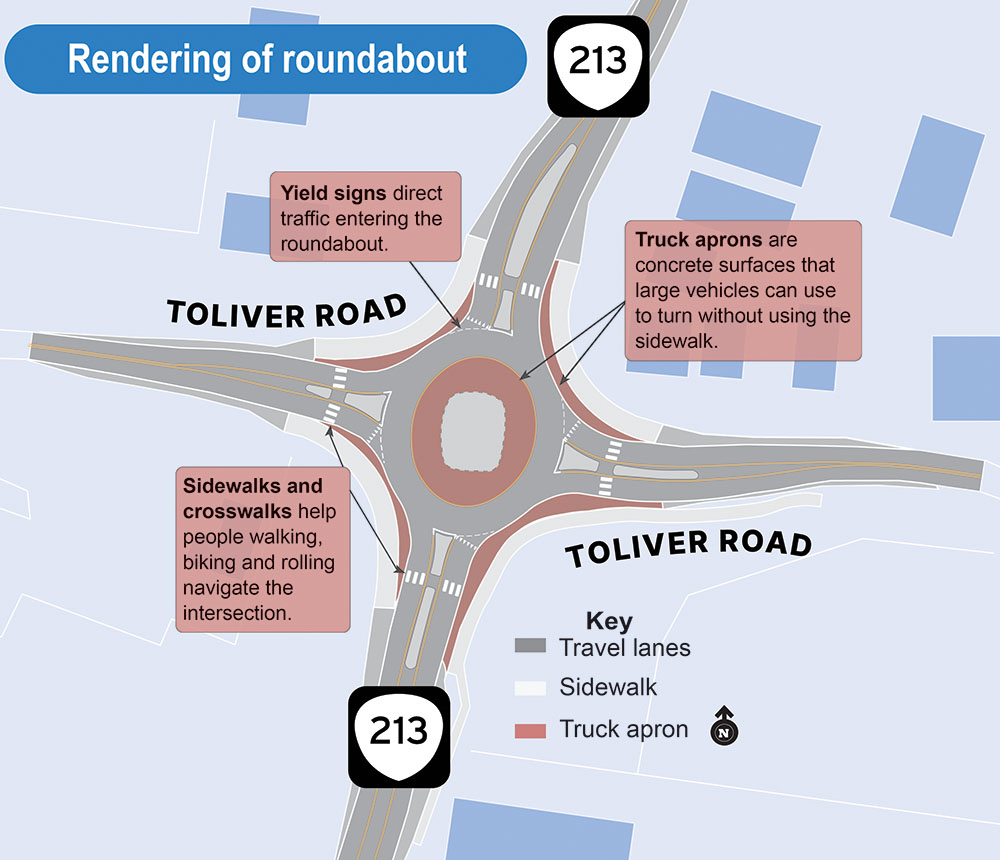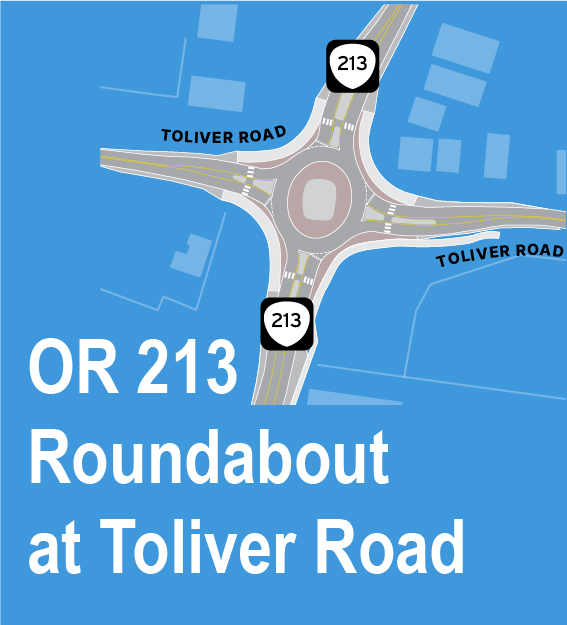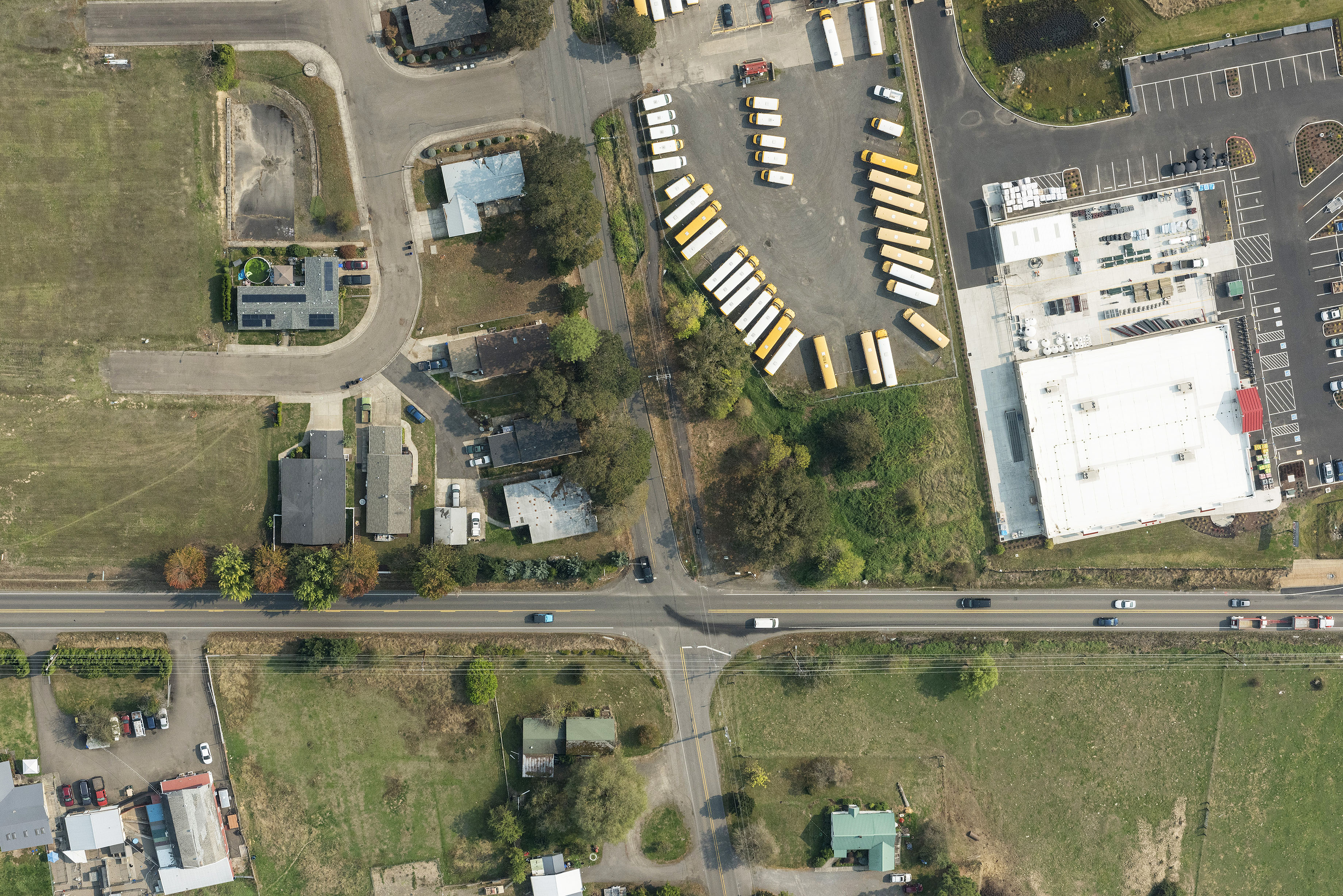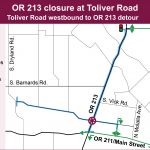Features on this site may be easier to use if you rotate your screen.
Additional Information
Currently, the intersection of OR 213 and Toliver Road is controlled by stop signs on Toliver Road and has a high rate of crashes. A roundabout will improve safety by reducing sharp turns while also accommodating the type of traffic that uses it, including large vehicles like trucks, buses and agricultural equipment.
A roundabout is a type of circular intersection that uses yield signs to control traffic entering the intersection and reduce speeds and high-speed head-on, right-angle and turning crashes, which improves safety.
Stations
Roundabouts are a circular intersection using yield signs. They reduce speed and crashes.
Learn how to navigate a roundabout safely.
The intersection of OR 213 and Toliver Road will be closed during construction.
Learn about utility work impacts, lane closures and nighttime noise
Learn how to receive updates on construction and traffic impacts.
 Why a roundabout
Why a roundabout
The intersection of OR 213 and Toliver Road has a high crash rate, within the top 10 percent of all highway segments in the state. A roundabout was found to facilitate all directions of traffic and turning movements while bringing the greatest safety benefits, including reducing speeds into the community.
According to the Federal Highway Administration, roundabouts are safer than traditional intersections. Locations with roundabouts can see a:
-
90 percent reduction in fatalities.
-
76 percent reduction in injuries.
-
35 percent reduction in all crashes.
While we evaluated a traffic signal, installing new traffic signals can result in an increase in rear-end crashes. In rural areas, new traffic signals are associated with a 77 percent reduction in angle crashes, but also a 58 percent increase in rear-end crashes, which can be severe and fatal in high-speed areas. Traffic signals do not address speeds at an intersection − roundabouts do reduce speeds. Often drivers accelerate through an intersection to try to make it through before the signal turns red, which is dangerous.
Our Road Safety Audit and Intersection Control Evaluation Report are available on the project website.
Can trucks/buses/farm equipment use a roundabout?
Yes! The roundabout is designed to accommodate the types of vehicles that currently use this intersection, including school buses, farm equipment and trucks. Truck aprons are concrete surfaces that large vehicles can use to turn without using the sidewalk. Vehicles such as fire trucks and school buses can use the roundabout without needing to use the truck aprons.
If you are concerned about a piece of equipment fitting through the roundabout, please contact the project team.
Using a roundabout safely
For drivers
Approach | Slow down as you approach the roundabout. Look for signs to determine where your exit is located. Watch for people on bikes; they will either merge into traffic or use the sidewalk. When approaching the crosswalk, stop for pedestrians using the crosswalk in your lane.
Enter | Traffic in the roundabout has the right-of-way. Before you enter the roundabout, you must yield to traffic inside and exiting the roundabout.
Wait for a gap and merge into traffic. Be prepared to stop if necessary.
Wait for a gap and merge into traffic. Be prepared to stop if necessary.
Proceed | Once inside the roundabout, move around the circle until you reach your exit. Allow bicycles that have merged into traffic the full travel lane and don’t pass.
Exit | Indicate your plan to exit using your right turn signal. Watch for people in the crosswalk and be prepared to stop.
For people riding a bike
You can navigate the roundabout like a motor vehicle would, or use the sidewalk and crosswalks. If you use the sidewalk, yield to people walking, travel at a walking speed or walk your bike.
For people using the sidewalk
Stay on the sidewalk or in designated crosswalks. When preparing to cross, watch for oncoming vehicles to make sure they stop for you before proceeding. Cross one direction of travel at a time and wait at the islands in the crosswalk until your path is clear.
Emergency Vehicles in Roundabouts
Do not enter a roundabout when emergency vehicles are approaching. Pull over to the right. Allow other vehicles to clear the intersection so the emergency vehicles can move through the roundabout. Never stop while inside the roundabout. Instead, move through and exit the roundabout. Once you exit, pull over to the right shoulder and allow emergency vehicles to pass.
We evaluated two methods for constructing the roundabout. The first method involved a six month construction timeline with lane closures, weekend full closures of OR 213 and each leg of Toliver Road fully closed at OR 213 for up to six weeks each.
The second method, which we selected, condenses the construction timeline to an eight week full closure of the intersection and minimal lane closures before and after the full closure. This method increases safety for travelers and workers, is an efficient use of time, reduces project costs for traffic control and results in a higher quality roadway with fewer paving joints, which reduce potholes and increase the lifespan of the pavement.
The intersection of OR 213 and Toliver Road will be closed for construction starting as soon as July 6, 2023.
The schedule was selected based on timing requirements for work in the creek as well as minimizing impacts to the public by scheduling the closure for after the Molalla Buckeroo Rodeo. We will keep you informed about the closure schedule.
Please note an update for people walking and biking during construction. For eight weeks in summer 2023, the intersection of OR 213 and Toliver Road will be fully closed to all traffic, including people walking and biking. The entire intersection will be excavated at one time, which will leave a hole in the roadway. Because of this, we can’t provide a safe, accessible path through the work zone without increasing the duration of the closure.
All vehicles will need to use the signed detour routes or other alternate routes.
-
Through traffic on OR 213 can follow a signed detour using OR 211/Main Street and South Union Mills Road.
- Eastbound traffic on Toliver Road bound for OR 213 can head north on South Dryland Road and turn right onto South Barnards Road, or head south on South Dryland Road and turn left onto OR 211/Main Street.
- Westbound traffic on Toliver Road bound for OR 213 can use Leroy Avenue and turn left onto OR 211/Main Street for OR 213 north, or turn right onto OR 211/Main Street for OR 213 south.
We do not plan to use flaggers to direct traffic along detour routes during roundabout construction.
Click through images to view the detour maps.
Open gallery full-screen
Use the mouse wheel to pan and zoom, or pinch and swipe on touch-enabled devices.
Utility relocation
Several utility providers must relocate utilities in the construction area before work can begin. Work to relocate the NW Natural lines at the intersection will require nighttime lane closures on OR 213 and day or nighttime lane closures on Toliver Road in spring 2023. We will share more information online and to our email subscribers list in advance of this work.
Summer 2023 lane closures for roundabout construction
Minimal nighttime lane closures with flaggers directing traffic on OR 213 before and after the full closure.
Day and nighttime lane closures on Toliver Road before and after the full closure.
Day and nighttime lane closures on Toliver Road before and after the full closure.
Nighttime noise
Those living or working in the area may hear noise from construction. A 24/7 nighttime noise hotline will be available during construction for noise concerns.
 There are several ways to stay up to date on this project:
There are several ways to stay up to date on this project:
- Visit the project website: www.ToliverRoundabout.org
- Sign up for email updates on ODOT projects in Molalla.
- Check TripCheck.com for up-to-date traffic impacts during construction.
- We will provide a project update at the Dec. 14 Molalla City Council meeting located at 315 Kennel Avenue. Before the meeting, from 6-7 p.m. staff will be available to answer questions.
Questions or comments?
Katelyn Jackson, ODOT Community Affairs
Katelyn.Jackson@odot.oregon.gov | 503-731-8503
Katelyn.Jackson@odot.oregon.gov | 503-731-8503

 Constructing the roundabout requires widening the intersection at Toliver Road and replacing an existing culvert carrying Bear Creek under Oregon 213. Work in the creek must be done during low-water levels and at a time when fish are unlikely to be present. This section of the creek is often dry through the summer.
Constructing the roundabout requires widening the intersection at Toliver Road and replacing an existing culvert carrying Bear Creek under Oregon 213. Work in the creek must be done during low-water levels and at a time when fish are unlikely to be present. This section of the creek is often dry through the summer. 





